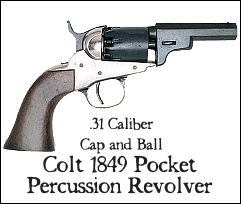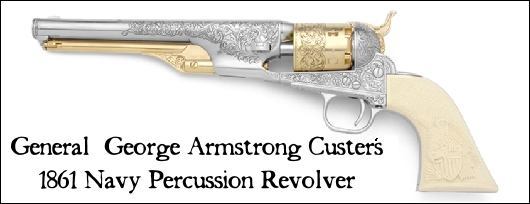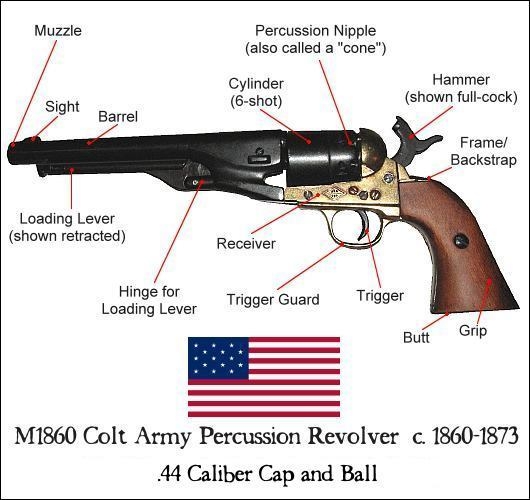Colt Percussion Revolvers: Army and Navy Models, and Pocket Pistols. 1849-1873

In the Frazier International History
Museum in downtown
Louisville, Kentucky, there is a display featuring a set of custom
engraved 1861 Colt Navy percussion revolvers that reportedly were
presented to General George Armstrong Custer in 1863 for his
outstanding service in the Civil War. They are nickel plated
with
carved ivory grips, and possibly with gold or brass trim that is
partially worn off. They are in a box, complete with a full
set
of tools and a powder flask, and a few
bullets. You
can see the place on the grip of one of the pistols where a
presentation plaque had once been. Supposedly, Custer's widow
had
it removed before selling the set, for her own personal
reasons.
Where that plaque is today is anyone's guess, but should it ever
surface and match up, someone is going to get rich.
There
were actually quite a few Cavalrymen and gunfighters or lawmen
throughout American history who liked the Navy Colt percussion
revolvers, and some of the more fortunate ones had customized ones that
were beautifully engraved. Wild Bill Hickock had a
heavily-customized pair of Navy Colts, and there were many others who
had sets of the fancy Colt percussion six shooters. Some were
even converted over to the more modern metal cartridge style.
The
percussion firing system came about in the 1820s, and did
not really take off until around the 1840s. New
things are
often
slow
to take hold. Eventually, percussion weapons began
to
replace the old flintlock system. Colt produced Police and
Pocket
percussion pistols in 1847, followed by the now-famous 1851 Navy Colt,
although at the time, it's unlikely the name "Navy Colt" was actually
used. This led to the more successful percussion Colts of the
Civil War. The 1860-1861 Army and Navy model Colts were among
the
very last firearms using the old percussion system. 1860 was
the
year that Benjamin Tyler Henry unveiled his lever-action repeating
rifle that used a newly-perfected .44 caliber rimfire metal
cartridge--invented by Daniel Wesson and perfected by Henry.
Nobody may have seen it coming then, but the metal cartridges took the
world by storm, and quickly usurped the old percussion and black powder
weapons. This technology spread and developed like wildfire,
and
in a short time, centerfire cartridges and smokeless powder took the
place of rimfire (except in small calibers), and not long after that,
semiautomatic weapons. After centuries of using black powder
and
relatively simple flintlock firing mechanisms, the technology of
firearms was now on the fast track. Percussion revolvers
weren't
much more than an innovative, but short-lived technology to fill in the
gap between black powder flintlocks and the use of full-metal
self-contained cartridges.
Cap and Ball
percussion revolvers used a small sack (or tube-shaped "paper
cartridge") of nitrated paper or cloth filled with a measure black
powder, with a small lead ball or conical bullet packed on top of
it. This was done with either a ramrod, or in the case of the
Civil War-era Colts, a built-in rod (loading lever) on a hinge that
would pack the powder and bullet wad into a chamber in the
cylinder. The shooter would then attach a percussion cap, a
small
copper or brass open-ended cylinder enclosing fuliminate of mercury
onto the "nipple" (on the rear of the cylinder) which held it in place.
When struck by the hammer, the cap would detonate, flashing sparks
through a small hole on the back of the nipple into the revolver
chamber, igniting the main powder charge and firing the
bullet.
By placing the hammer in the half-cock position, the cylinder would be
allowed to rotate freely for loading. Obviously, this was a
much
lengthier process than what we employ today with the use of
self-contained metal cartridges. These were some of the last
of
the percussion-type weapons being developed.
The
predecessor to the 1860 Army and 1861 Navy Colts, was the Colt Pocket
revolver made in the late 1840s, and was also known as the "Baby
Dragoon" and the "Wells Fargo Pocket Pistol." The most
popular Pocket model was the 1849 model,
with
some variations being the Pocket Police Model and the Pocket
Navy. They were especially popular with the California Gold
Rush
crowd (Sutter's Mill, California '49 Gold Rush, remember?) and also
later, during the Civil War. The 1849 Pocket Pistols were set
in
.31 caliber and had 5-shot cylinders, and like the M1851, had an
octagonal barrel, but it was noticeably shorter than on the later
Colts, and much smaller than the original massive Colt
Dragoon. The Pocket Pistols were produced from 1847 to
1873.
This model introduced the successful single-action mechanism that was
still used in the M1860 Army and M1861 Navy Colt percussion six
shooters.
Some of th
e distinguishing
characteristics of the Civil War-era percussion Colts are the loading
lever, which hinges down to pack the bullet and charge into
t
he firing
chamber, and when finished, can be snapped back into place with a
spring unde
r the barrel. The M1860 Army had a cam in the
loading
lever hinge that would not allow the lever to fall all the way against
the barrel, should it happen to unclip itself and fall during recoil, a
handy addition from the older 1851. More than 200,000 of the
breech-loading percussion revolvers were produced between 1860 and
1873. While the Army percussion revolver was set in .44
caliber,
the Navy version was set in .36 caliber, and was produced in smaller
numbers than the Army model. The M1861 Navy had a shorter
cylinder, and less recoil than the M1860 Army, but otherwise was nearly
identical. Unlike its forbear the M1851, the 1861 had the "creeping"
cam feature on the loading lever. Some of the 1860-61 models
had
fluted cylinders and arrangements for an optional shoulder stock, but
most did not. The 1860-61 Colt revolvers had round barrels,
while
the old 1851 models had octagonal barrels. All of these Colt
percussion revolvers from the M1851 through the M1861 were used heavily
in the Civil War.


Since the Colts--and most others too--were made in the American Northeast (Yep, Union territory!) the Confederate states didn't have access to to new supplies of the weapon once the hostilities began. They had to make do with whatever weapons they alread y had, import new ones from overseas, such as the LeMat revolver by smuggling them through the Union's Naval Blockade. They also had the option to make their own weapons, and they did, but with only limited success. One such weapon was the Griswold and Gunnison revolver. It was actually a bit crude conpared to the Colt revolvers, but was otherwise an exact copy of the M1851 Navy Colt, right down to the .36 caliber size. The Confederates had major issues getting the right kinds of metals they needed, and often ended up using a fused mixture of brass and steel, or whatever they could lay their hands on. Today, the homemade Griswold & Gunnison revolvers are extremely rare, and worth a fortune to collectors, some of whom have paid over a million to get one. The Colt percussion revolvers, produced in larger numbers are not quite as rare, however, if you ever see one (or a pair of them) at auction, complete with a wooden box, bullet mold, original powder flask and other tools, in good shape, and especially if it's engraved or was owned by a famous person, be prepared to spend at least that much. One that's in very good shape, even lacking the engraving or the famous person angle, means that you're looking at a price tag of at least US $400,000, and up to $750,000. Of course, if you can't spare three-quarters of a million bucks for a classic firearm, you could always get a nice, non-firing or blank-firing replica, that looks, feels and acts like the original, right down to the mechanical action, but costs much less. Your Call. Here below is a video showing the non-firing replica of the 1860 Colt Army Percussion Revolver:
Firearm Type:
Cap and Ball Percussion Revolver, Single Action
Nation Of Manufacture: USA 1847-1873
Military Service Dates : 1861-1865, also
used at other times
Variations: 1849 Pocket (Police, Navy),
1851 Navy, M1860 Army, M1861 Navy
Ammunition: .31 Cal. (1849 models) .36 Cal
(M1861 Navy) .44 Cal. (M1860 Army)
Wars: US Civil War, other conflicts
Recent Prices at Auction for Originals: US
$6,000-$1,000,000 (depends on condition)
Interested in an authentic replica 1860 Colt Army
Pistol? (2 different finishes)
We also offer a non-firing replica of
an 1849 Colt Navy Pocket Revolver
And we have authentic replicas of engraved 1851
Colt Navy Pistols .
Call Us Toll Free in the US and Canada:
1-800-258-5167
